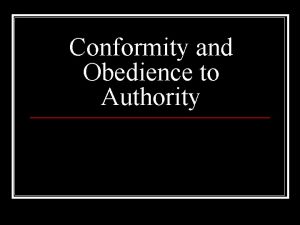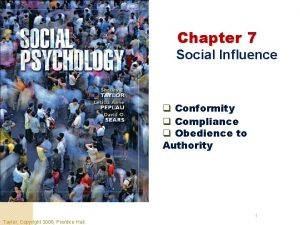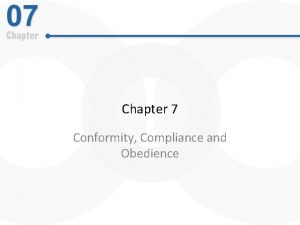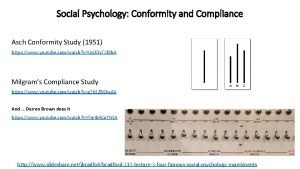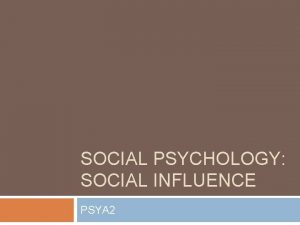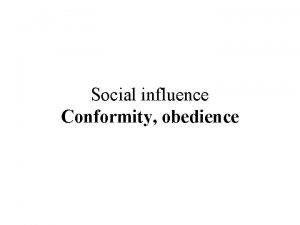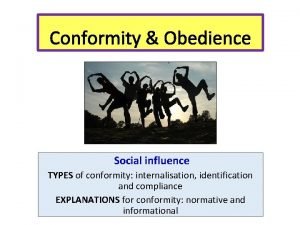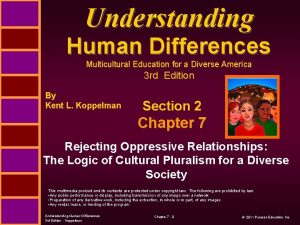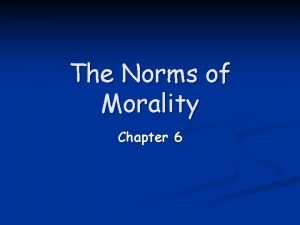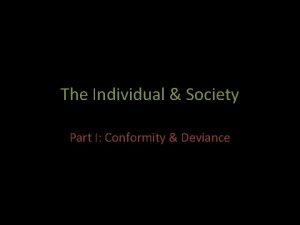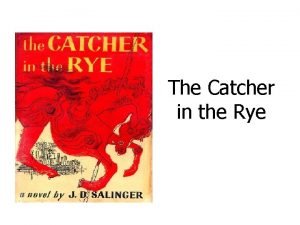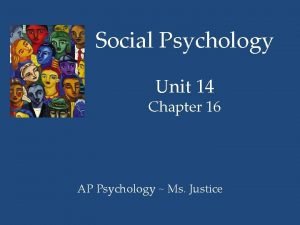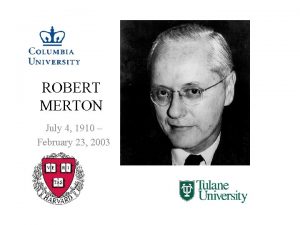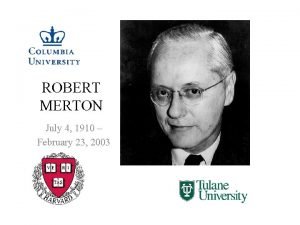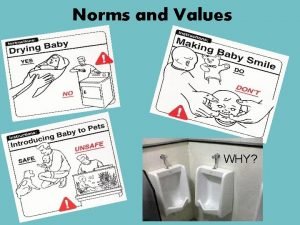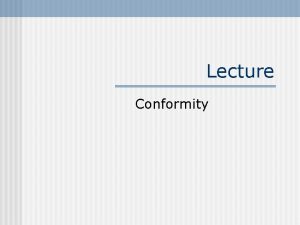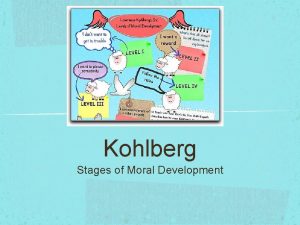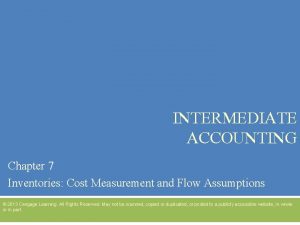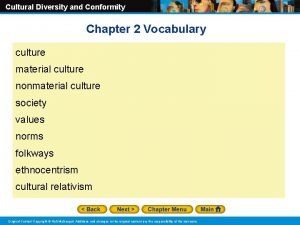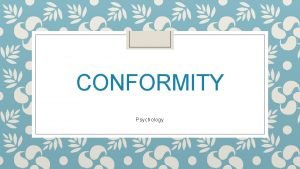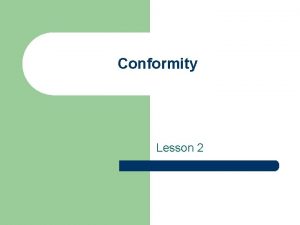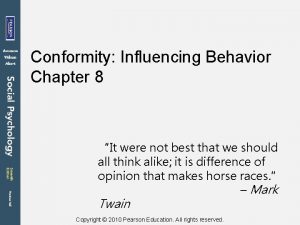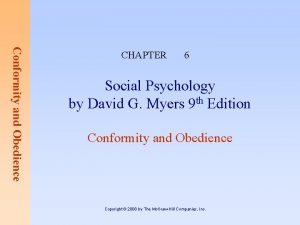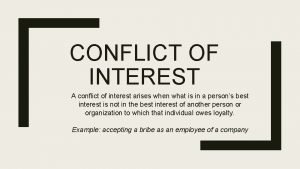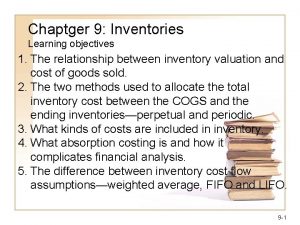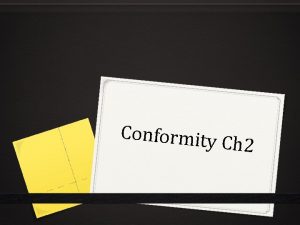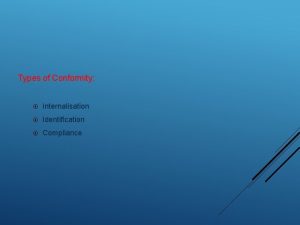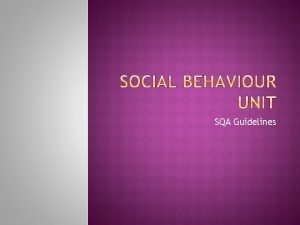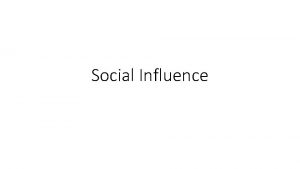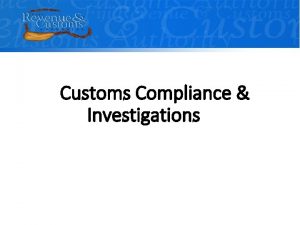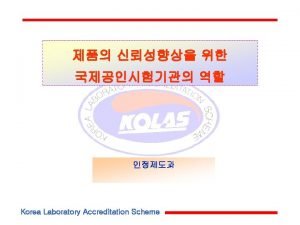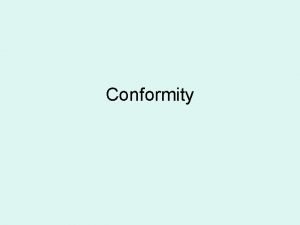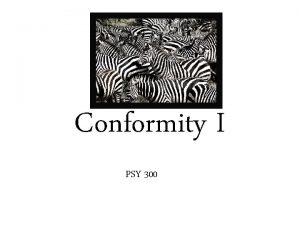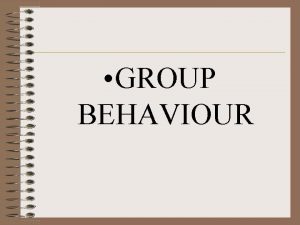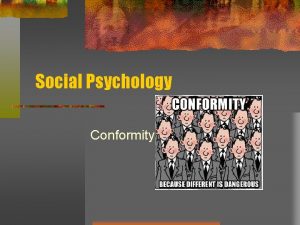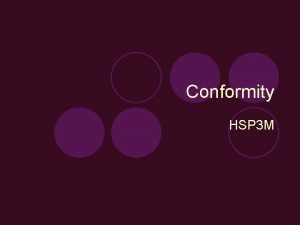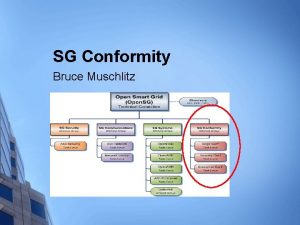Conformity Aschs Study of Compliance Types of Conformity





































- Slides: 37

Conformity Asch’s Study of Compliance

Types of Conformity • Compliance • Identification • Internalisation

The three types of conformity. . . ? • Which am I? • I have just joined a new job and everyone goes out drinking lots after work. I have never been a big drinker but I actually agree that its the best way to wind down and to socialise so I go along too. • The other day in English class everyone started laughing at something in the book we were reading. I didn't really find it funny but didn't want to sound stupid so laughed along anyway. • I used to have a real issue with asylum seekers and the UK border system but have recently attended Afghanistan where I met many wouldbe asylum seekers. Now I think totally differently and want to support these people.

What is the difference between. . . ? • Compliance and internalisation? • Internalisation and identification? • Identification and compliance?

“A task of visual perception”

Instructions. . . • You must decide for yourself which line matches up and you should call out the correct answer

Instructions. . . • You must decide for yourself which line matches up and you should call out the correct answer



















Instructions. . . • You must decide for yourself which line matches up, but then call out the letter of the one which to you appears the longest (critical or experimental trials) • Do this on every trial except for the following, 1, 3, 7, 8, 11, 15 when you should call out the correct answer (control trials)

Instructions. . . • You must decide for yourself which line matches up, but then call out the letter of the one which to you appears the longest (critical or experimental trials) • Do this on every trial except for the following, 1, 3, 7, 8, 11, 15 when you should call out the correct answer (control trials)

Compliance • Researcher: Solomon Asch (1951) • Aim: To see if people conform to the majority in an unambiguous situation (i. e. The true answer is obvious!) • Procedure: • 123 male students took part in a test of ‘Visual Perception’. • In groups of 7 -9 around a large table.

Table arrangement 3 2 1 4 5 6 7

Compliance • Researcher: Solomon Asch (1951) • Aim: To see if people conform to the majority in an unambiguous situation (i. e. The true answer is obvious!) • Procedure: • The experimenter showed them 2 cards, 1 standard line and 3 comparison lines. • Ps called out A, B or C to which line matched the standard line, the answer was obvious.


Compliance • Researcher: Solomon Asch (1951) • Aim: To see if people conform to the majority in an unambiguous situation (i. e. The true answer is obvious!) • Procedure: • The experimenter showed them 2 cards, 1 standard line and 3 comparison lines. • Ps called out A, B or C to which line matched the standard line, the answer was obvious. • 18 trials in total • Confederates who called out the wrong answer in the critical trials (12 out of 18, 6 were longer 6 were shorter)

Results of Solomon Asch experiment Findings: Overall conformity- 37%, this was where the naive PP gave the same wrong answer on the critical trials. 5% conformed on every critical trial. 25% remained independent.

Asch (1951): Compliance • Conclusion: • Naive PPs mainly conformed to avoid standing out from the crowd. • • A few doubted their own eyes! People conform in order to not stand out from the group. Changed their external but not internal views. Therefore Compliance

Evaluation of Asch • Lacks Ecological validity • Lacks Temporal Validity • Unethical

P: One issue with Asch’s Study is that it lacks Ecological Validity P: One issue with Asch’s Study is that it lacks Temporal Validity P: One issue with Asch’s Study is that it lacks Ecological Validity E: This is because… E: This is an issue because… L: On the other hand…

Asch quiz. . . (AO 1) 1. 2. 3. 4. 5. 6. 7. 8. What is a critical trial? What is a confederate? How many confederates are there? What was the size of the group? What were three lines called? What was the one line called? Where was the naive participant seated? What was the compliance rate overall (i. e. % of the time that the naive pa gave the same wrong answer as the confed. )? 9. What was the % of people who conformed (complied) on every critical trial? 10. What percentage remained independent?
 Compliance vs conformity
Compliance vs conformity Conformity obedience and compliance are all examples of
Conformity obedience and compliance are all examples of Compliance vs conformity
Compliance vs conformity Compliance vs conformity
Compliance vs conformity Compliance psychology definition
Compliance psychology definition Conformity psychology
Conformity psychology Asch
Asch Conformity internalisation
Conformity internalisation Ecological study vs cohort study
Ecological study vs cohort study Retrospective cohort study vs prospective cohort study
Retrospective cohort study vs prospective cohort study Work study definition
Work study definition Marty lobdell study less study smart
Marty lobdell study less study smart Phytogeographical regions of india by d chatterjee
Phytogeographical regions of india by d chatterjee Differentiate between time study and motion study
Differentiate between time study and motion study Time and motion study example ppt
Time and motion study example ppt Anglo-conformity
Anglo-conformity The remote norm of morality
The remote norm of morality Example of conformity deviance
Example of conformity deviance Conformity in catcher in the rye
Conformity in catcher in the rye Passionate love ap psychology definition
Passionate love ap psychology definition Elevator conformity experiment
Elevator conformity experiment Role theory sociology
Role theory sociology Conformity; innovation; ritualism; retreatism; rebellion *
Conformity; innovation; ritualism; retreatism; rebellion * Ped directive guidelines
Ped directive guidelines Examples of mores in sociology
Examples of mores in sociology Informational conformity definition
Informational conformity definition Kohlberg premoral stage
Kohlberg premoral stage Dollar value lifo
Dollar value lifo Cultural diversity and conformity section 1
Cultural diversity and conformity section 1 Cultural diversity and conformity section 3
Cultural diversity and conformity section 3 Conformity psychology
Conformity psychology Asch conformity experiment
Asch conformity experiment Normative conformity example
Normative conformity example What is conformity
What is conformity Authority conformity
Authority conformity What predicts conformity?
What predicts conformity? Conformity bias
Conformity bias Lifo liquidation formula
Lifo liquidation formula

